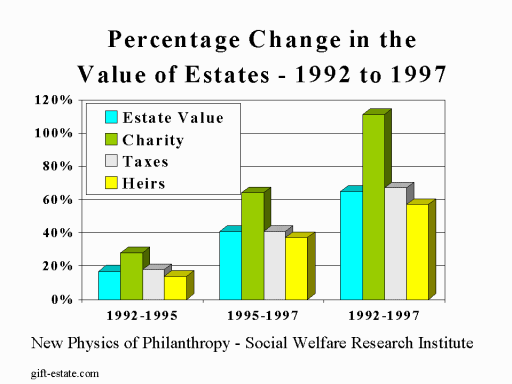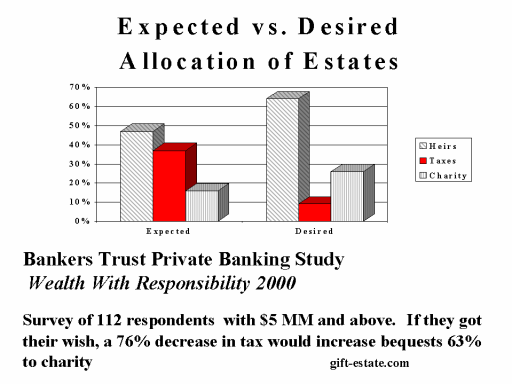Charitable Giving Without the Estate Tax? – Vaughn W. Henry & Associates
Charitable Giving Without the Estate Tax?

COMMENTARY ON CURRENT EVENTS
Vaughn W. Henry
Many in the charitable and estate planning community have expressed concerns about changes in the estate tax that might diminish support for philanthropic causes. By promoting charity as the last and best tax shelter available to people seeking tax relief, now they find themselves wondering if tax relief has a down side.
Wealthy taxpayers assume that taxes will take a major chunk out of their estates, but if they had the ability to self direct their estate assets, they’d choose to reduce tax so more would flow to heirs and charitable causes decreasing the tax increases bequests.

Recently, Professor Paul Shervish of the Social Welfare Research Institute (one of the authors of the widely quoted Millionaires and the Millennium New Estimates of the Forthcoming Wealth Transfer and the Prospects for a Golden Age of Philanthropy) has reversed course and presented interesting arguments that an estate tax repeal might not threaten charitable giving as much as many fear. His position is that when people have choices and control of more of their assets, they feel more comfortable to support charitable causes. The two charts above summarize the changing trends about concepts and the reasoning behind this somewhat unconventional position. The trend in estate value has been to grow, and yet the distributions to charity, taxes and heirs have not been changed in the same proportion.
| Year | Estate Tax Revenue |
| 1990 | $10 billion |
| 1995 | $15 billion |
| 2000 | $26 billion |
| 2005 | $40 billion |
While it flies in the face of conventional and political wisdom (i.e., charitable giving is motivated by tax relief), most successful philanthropic planners know that having a strong connection to a charitable cause is more compelling than just tax avoidance planning. However, many nonprofit organizations, insurance carriers, financial and legal advisors all have expressed concerns about the loss of charitable support if the estate and gift tax is repealed. Whether this is cynical protection of a revenue stream or a legitimate expression of concern, no one really knows — but it does further confuse the issue. A recent commentary by Professor Stephen Leimberg on the estate tax bills passing through Congress seriously pokes holes in the legislation offered to date. Too bad, few lawmakers have read material from practitioners in the field, rather than being swayed by an emotional “call to arms”.
What has been observed from the 1992 – 1997 statistics on estate values and charitable bequests is that transfers to nonprofit organizations have grown faster than transfers to either heirs or tax payments, so there seems to have been a significant shift in thinking by clients and their advisors to conserve “social capital”. Will this trend continue?
“In a 1997 article in Philanthropy magazine, Hudson Institute economist Alan Reynolds took a look at a prediction by Independent Sector that the 1986 Tax Reform Act, which reduced the top marginal income tax rate to 28% from 50%, would lead to an $8 billion decline in giving. Actually, giving rose $6.4 billion the following year, and a total of $40 billion a year between 1987 and 1994. (Charitable giving now amounts to nearly $200 billion annually.) The key factor in giving, it turns out, is economic growth and wealth, not tax rates. “The surest way to increase charitable giving,” wrote Mr. Reynolds, “is to increase the number of families earning high incomes.” – Wall Street Journal Feb. 27, 2001
Of special concern to planners in light of recent market gyrations is what happens to charitable trusts when there is a market downturn and how trusts should be designed to weather those periodic storms. Here are previews of the articles due out this month:
(1.) Payouts Aren’t Payoffs – What investment strategy works in a charitable trust http://gift-estate.com/article/payout.html
(2.) Practice Building – Understanding the interaction between commercial advisors and nonprofit gift planners http://gift-estate.com/cch-article.htm
 CONTACT US FOR A FREE PRELIMINARY CASE STUDY FOR YOUR OWN CRT SCENARIO or try your own at Donor Direct. Please note — there’s more to estate and charitable planning than simply running calculations, but it does give you a chance to see how the calculations affect some of the design considerations. Which tools work best in which planning scenarios? Check with our office for solutions.
CONTACT US FOR A FREE PRELIMINARY CASE STUDY FOR YOUR OWN CRT SCENARIO or try your own at Donor Direct. Please note — there’s more to estate and charitable planning than simply running calculations, but it does give you a chance to see how the calculations affect some of the design considerations. Which tools work best in which planning scenarios? Check with our office for solutions.
4/3/01